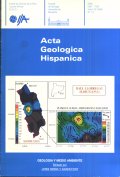Procesos de alteración de materiales pétreos en edificios de interés histórico
Abstract
This is a general survey of the different stages in the technicaldiagnostic activities carried out at present on the conservation state of monuments previous to restoration.
Diagnostic studies are commonly hased on the effects of pollution (external factor), and on the study of rock porosity and its hydric properties (interna1 factors). Other alteration processes may also be caused by the mineralogical nature, as well as the crystallochemical characteristics of the rock. These mechanisms may be determinig factors that can go unnoticed if no in-depth petroiogicai and crystallochemical studies are carried out, especially those using the new techniques of electron microscopy and electron drilling.
Here a rock of Miocenic age from the " Covas del Llorito" near Tarragona quarries is described. This partially dolomitized calcisiltite presents a zoned idiotypic fabric, with an anomalous intracrystalline distribution of calcium and magnesium, non-stechiomehic and deficient in magnesium. These crystalls undergo a differential disolution of their nuclei, wich produces abundan1 intracrystalline moldic porosity, and subsequent disaggregation and the formation of sand. This predisposition to alteration, of diagenetic origin, is speeded up by existing gypsum efflorescences, external to the rock.


